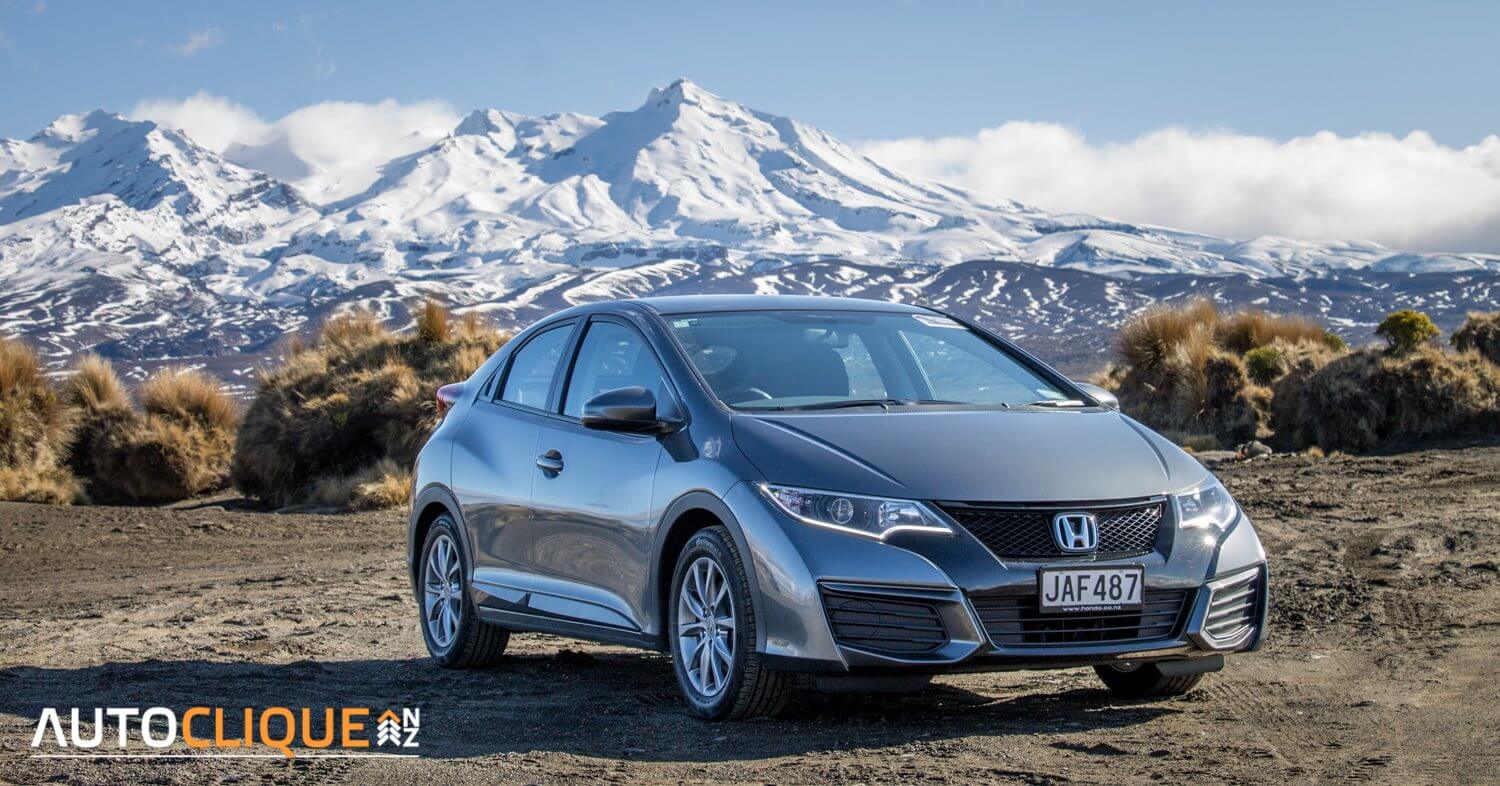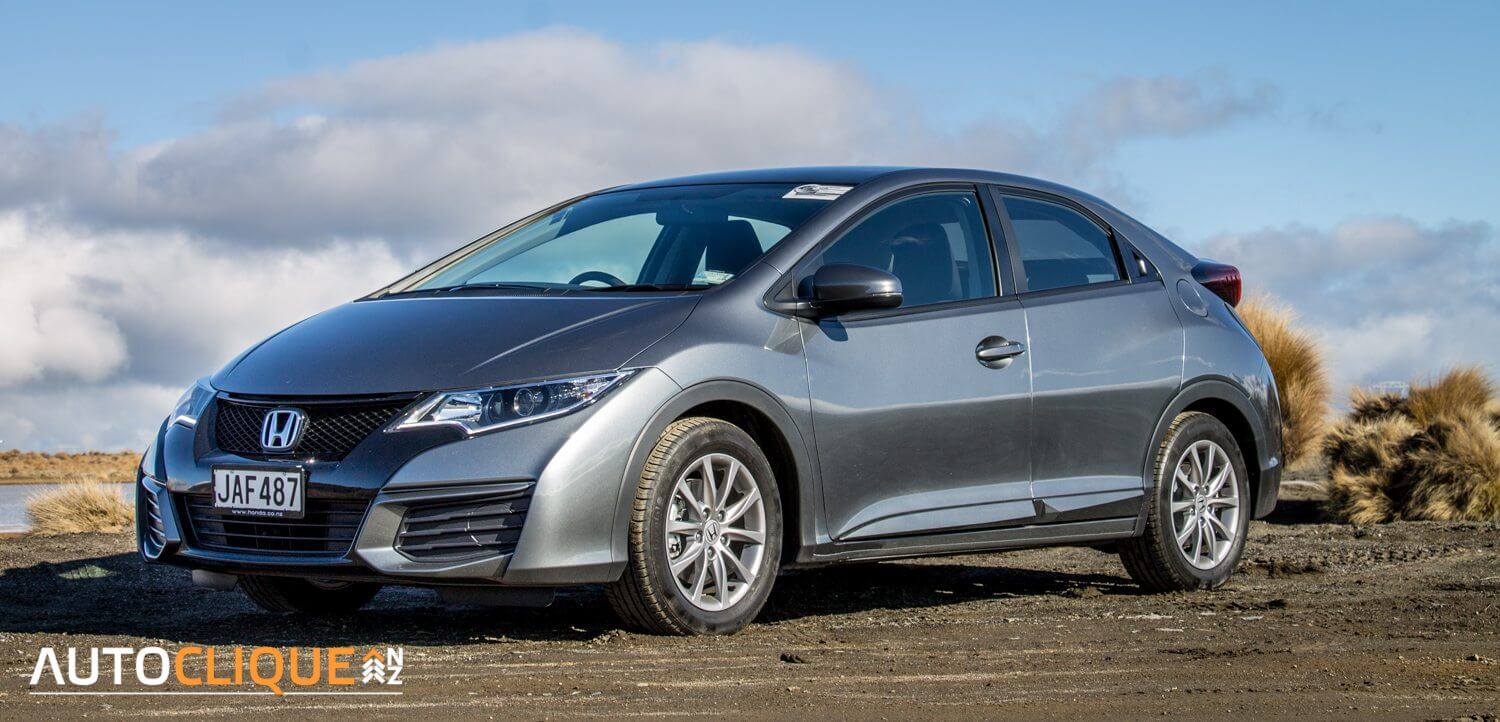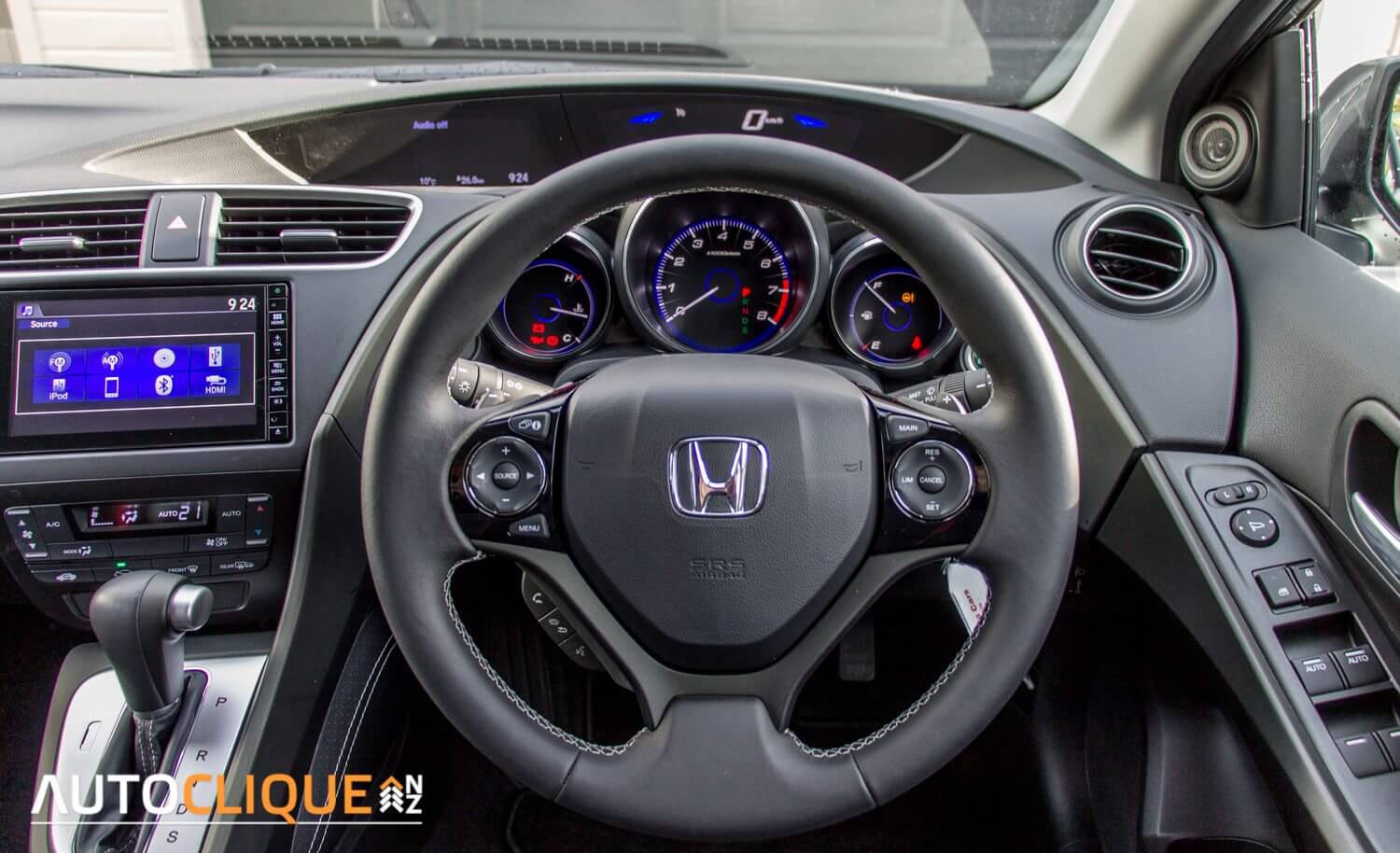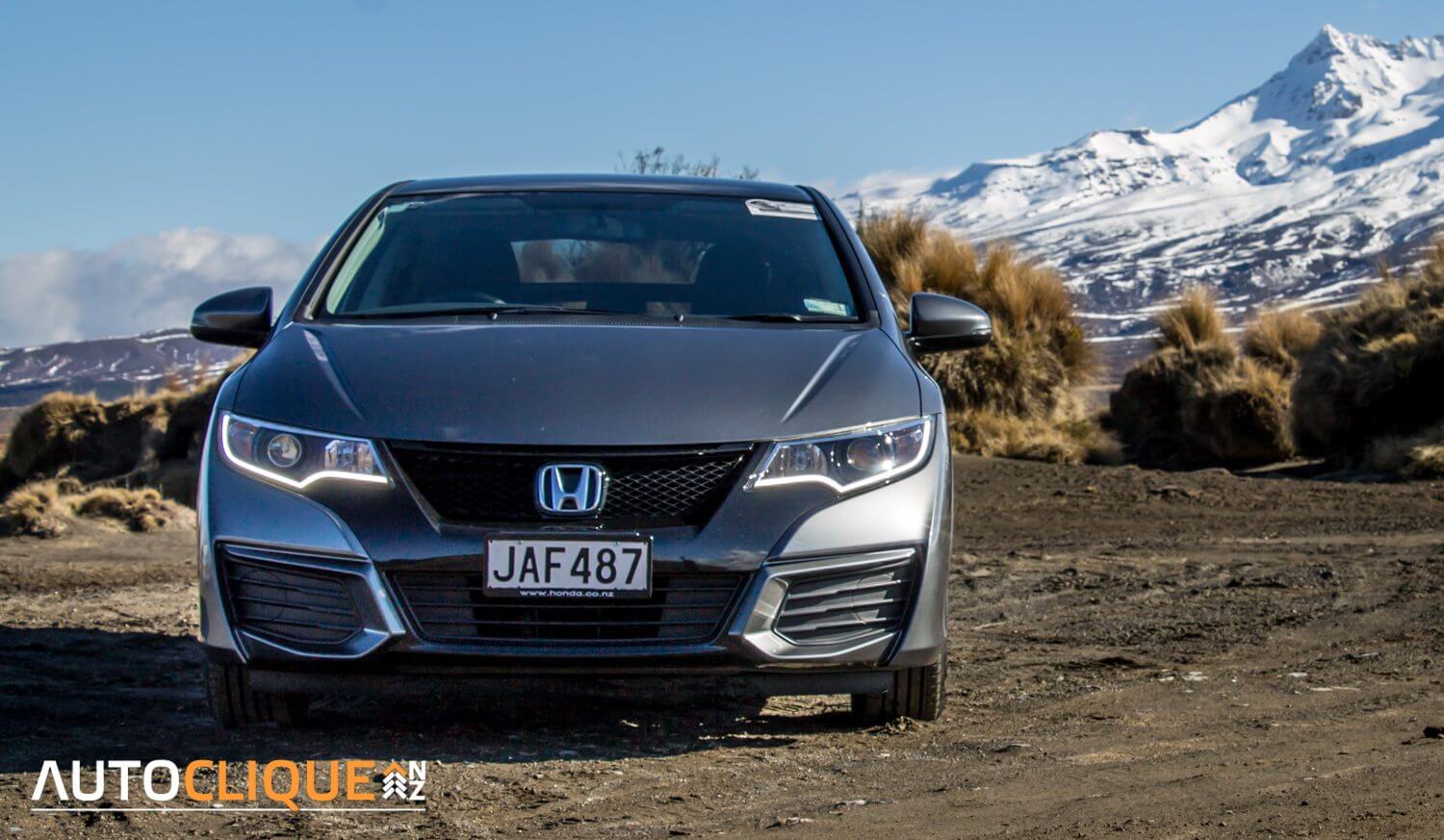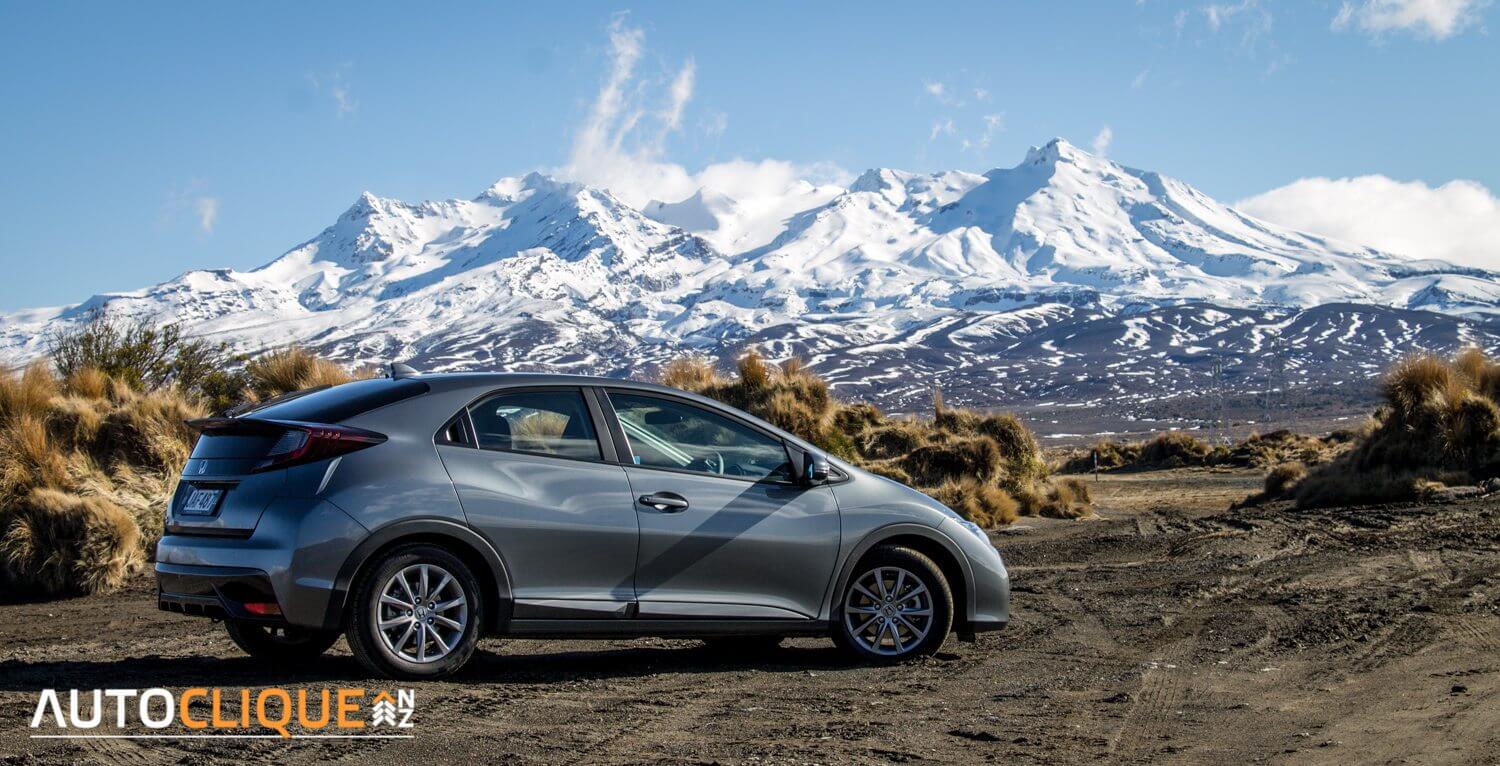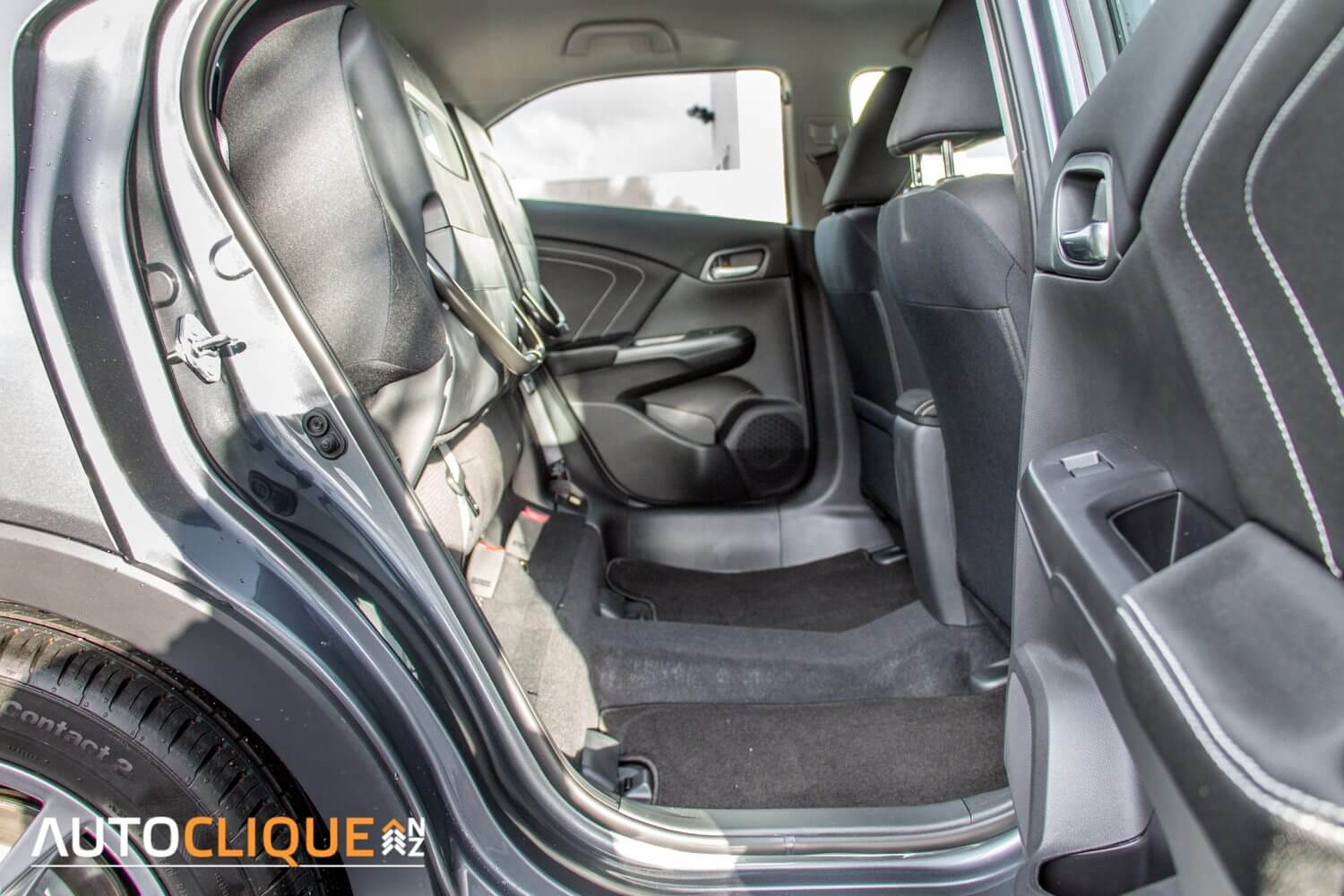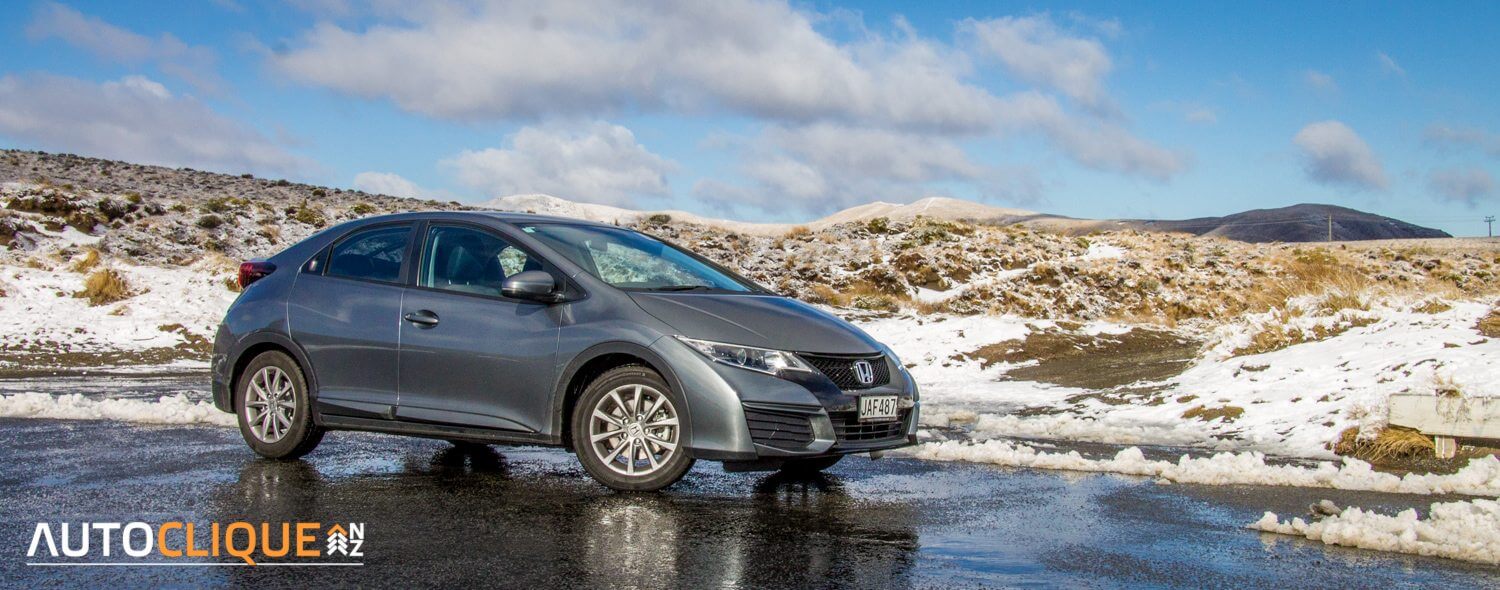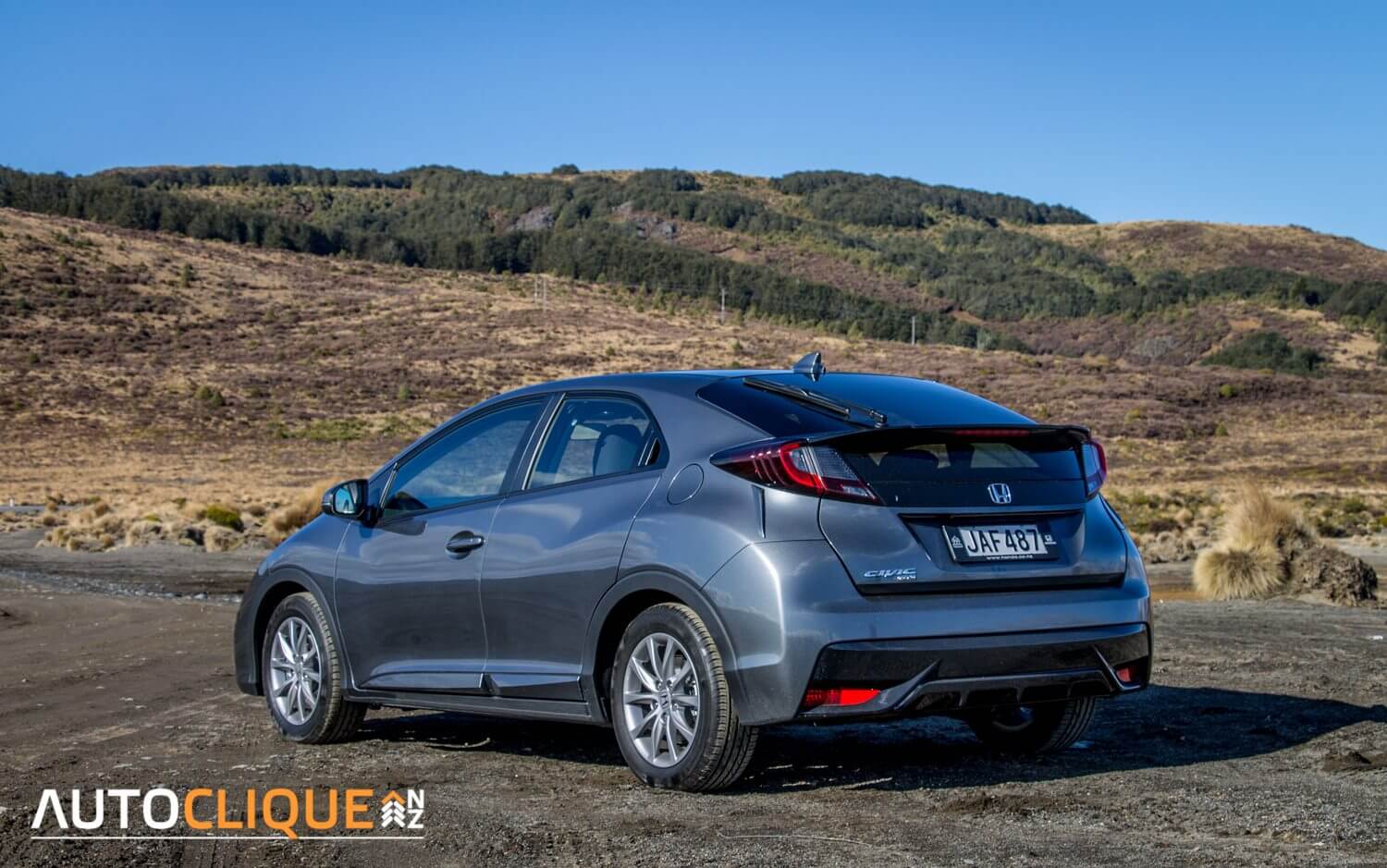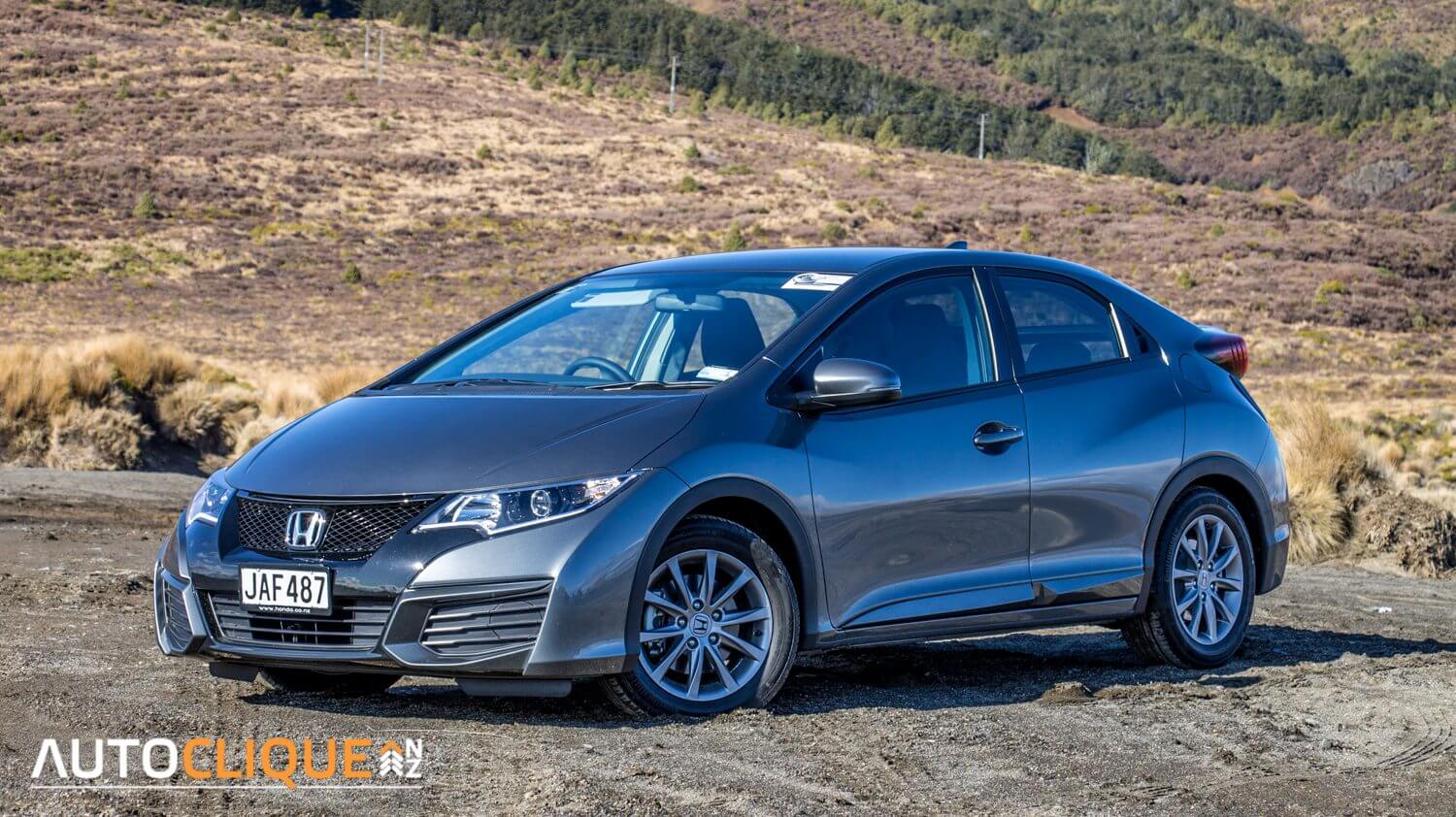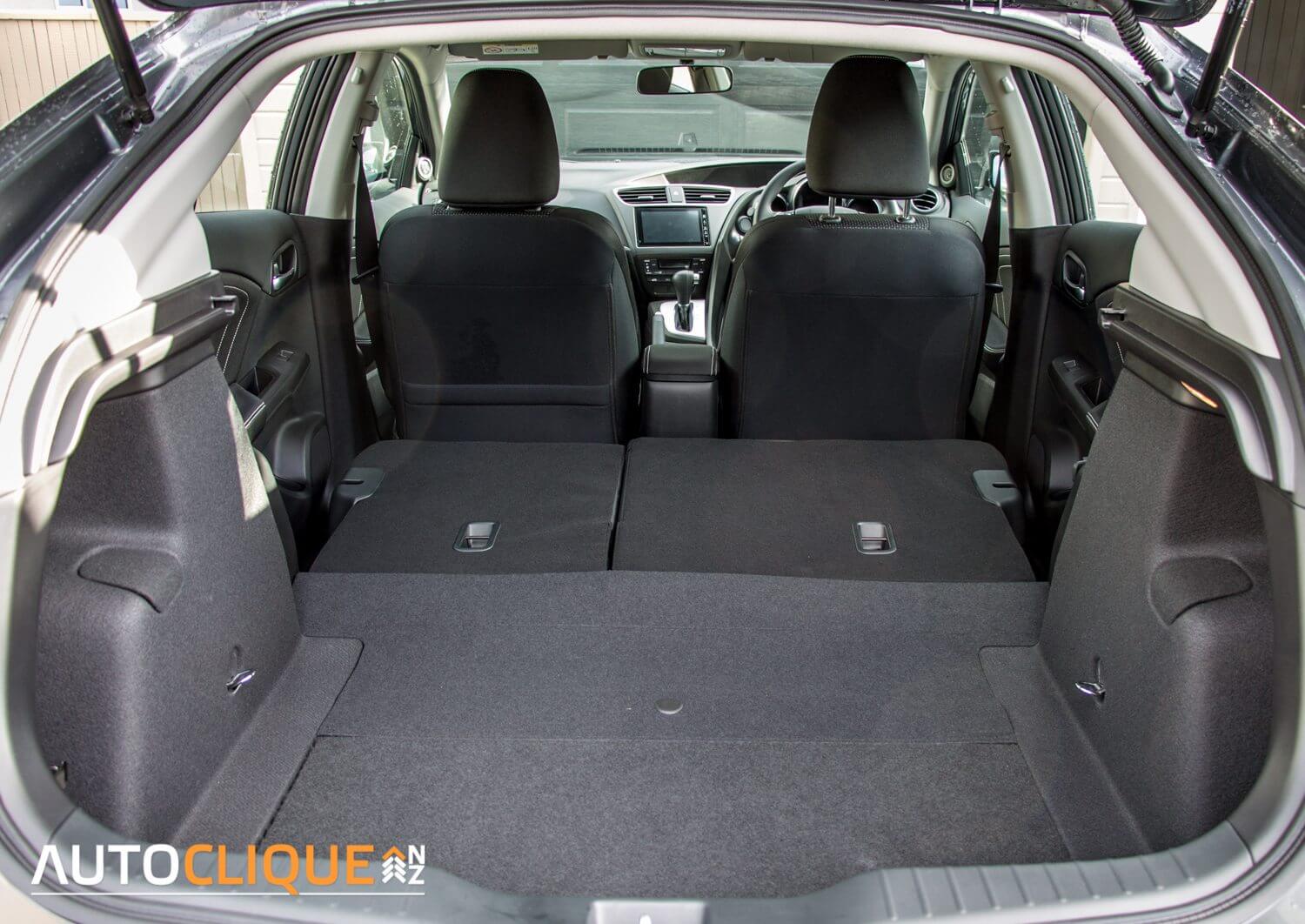Honda New Zealand very kindly offered a Euro Civic to us to drive from Wellington to Auckland to attend the 2015 CRC Speedshow. The ninth generation Civic has been available in NZ for several years now, and a new facelifted version has just been released. Back in 2006, Honda released a similarly shaped Civic in Europe, and at the time it looked pretty outrageous compared to other cars. I was a little disappointed at the time that they chose not to bring it to NZ. This model is an evolution from that car and though it doesn’t stand out as much from other modern cars as that one did, it looks different enough to stand out in a market place that seems to be converging on a “common” design that makes it hard to tell the brand without looking at the badge.
Tested here is the base model, S spec facelift. Amongst other things, the facelift integrates the daytime running lights into the headlights, which I think is a big improvement over the previous ones, which seemed a bit in-your-face. The higher spec LN model adds leather, 17” alloys, keyless entry, auto wipers and headlights, and privacy glass.
First Impressions
The interior’s pretty nice. Multiple dashboard screens with a big central digital speedo, a second screen to the left for additional info and menus, encased in a big swooping instrument binnacle. This is complemented by an 8” touch screen entertainment system, which to my delight has physical, tactile buttons at the driver’s side of the screen. The door and central tunnel are shaped so that they lead into the dash, tying the whole thing together well.
Like most modern cars, the central touch screen has a message that you have to acknowledge every time the car is started, saying you are in charge of the vehicle and responsible for your actions. If this is not pressed the screen goes into a screen saver mode which is a bit fiddly to get back out of. Initially it’s an annoyance but pressing it would quickly become a habit.
Pete and I collected the car from Honda in Wellington the day before Speedshow. After a quick stop to put our gear in the boot – which it swallowed easily – we set off up State Highway 1 to Auckland. The Honda feels quite firm at first but it does absorb the bumps well. It coped very well with my favourite suspension testing section of SH1 near Queen Elizabeth Park. The firmness means that it gives good feedback through the wheel and corners really well. The steering is electric, and is very light, especially at low speeds. I realised how light when I got back into my own car and wondered if my power steering was broken.
When cruising along the highway the Euro Civic is impressively quiet. The engine is barely audible and other noises are well-damped, giving a real feeling of refinement. On the rougher sections of highway there’s quite a lot of noise from the tyres, and over 80kph I could hear a very high-pitched wind whistling sound (but Pete didn’t notice it).
Get to a hilly section and press the accelerator a little harder and at first there’s not much power from the 104kW VTEC engine. The pedal has a kind of squishy feeling where you press but not much seems to be happening. As with all Honda VTEC engines it makes its power high up the rev range, so press the pedal more aggressively and it starts to liven up. Maximum power is to be had at 6,500rpm with the red zone starting at 6,600rpm, so you really need to rev the Civic to get the most out of it when you need some go.
What’s it like to live with?
As the journey progressed I realised I was enjoying driving the Civic. A lot of the journey was done with cruise control and this was one area where the car was a little disappointing. Up hills it was slow to pick up speed, often dropping from the set speed by about seven or eight kph then suddenly kicking down and accelerating back up to the set speed. Down hills it was a similar story. The cruise doesn’t use the brakes, it changes down through the gears to try and slow the car, but a couple of times we got up to 12kph or more than the set speed before it tried to slow and that’s definitely something that could get you a ticket! Obviously it’s the driver’s responsibility to prevent this (as that warning kept telling us!) but it was a little irritating. It might have been a calibration issue with our individual car and Honda are checking that out. The Odyssey we recently tested didn’t do this at all, but it had a CVT. One thing I did like about the cruise was that when it’s active, the set speed is constantly on a display next to the speedo, so you always know what it’s set to, and it’s easy to adjust to what you need using the buttons on the steering wheel.
By this time we had made good use of the two cup holders in the central console as well as the bottle holders in the doors (which just squeeze in a Pump bottle). Our phones were plugged into the sockets in the central arm rest – one power and two USBs. The cubby in the lid was just big enough to fit my smartphone but only if I put it in at a slight angle. We also tested the Bluetooth phone pairing which worked very well, with a nice clear sound when calling.
We cruised along the desert road and pulled over to take a few photos with the impressive snowy backdrop of Mt Ruapehu and Mt Ngaurahoe. I took this opportunity to have a play with what Honda call the Magic Seats in the back of the car. The Civic has the petrol tank under the front seats, meaning the floor in the back is much flatter and there’s room for different rear seat configurations. The 60/40 split rear seats have a space underneath that’s great for stashing things, and hiding things you don’t want to be seen when you leave the car parked. When the backs are folded down they use this space to enable the load area to be completely flat. Then there’s their party trick which I haven’t seen in a car before, the seat base folds up, making a load space for tall, thin loads.
We set off again and the twisty section after the Desert Road gave me a chance to get a better feel for the Civic’s handling. It has a system called Agile Handling Assist which works in a similar way to ESP but is used to improve cornering. Here’s Honda’s description: “When required the Agile Handling Assist System applies a light braking force to individual wheels during cornering. This is to maximise vehicle responsiveness and stability and is imperceptible to the driver.” Well it certainly seems to work. I chucked the Civic into a couple of tight corners and it handled them very well, keeping to the line and just going where I pointed it. I also realised at this point that the seats have side bolsters which hold you in place nicely.
There were a couple of overtakes to perform at the slow vehicle bay sections, and once I got the revs up, we passed with relative ease, though I couldn’t shake the feeling that I was thrashing its nuts off!
You might have noticed in the photos that the Civic has gloss black trims on the steering wheel. These may look nice but in the winter with the low sun they caught the light and reflected a patch onto the ceiling of the car which moved around every time I steered. I found this very irritating and distracting at several points during our trip. If it was my car I’d find a way to replace them or make them less reflective.
After a small detour near Taupo to look at a certain Audi I was thinking of buying, it was Pete’s turn to drive. As a passenger the car still feels comfortable and refined. After a couple of hours when I tried to put my legs backwards for a change of position where there’s normally a little bit of foot room under the seat I kicked the bulge where the petrol tank sits, which was mildly irritating but something you’d get used to. The rear is similarly comfortable, and there’s plenty of leg and knee room.
Pete didn’t like the positioning of the handbrake, which is at the passenger side of the centre console, and he also commented that he didn’t find the seats as comfy as I did after a long time sitting in them.
We stopped for a fuel and refreshment break South of Auckland, having completed 622km and using 6.1l/100km of fuel. The sticker in the petrol cap recommends 95RON fuel but we were at a Mobil station, so filled up with 98. I’m not sure if it was just my perception but the cruise control seemed a little better with 98 on board. It didn’t change the fuel economy for us, on the next 672km we used 6.4l/100km. Both are better than the quoted figure of 6.6.
Eventually we pulled up at our accommodation for the night. Our conclusion on the Civic was that it’s probably most at home in the city, but makes a comfortable and capable long-distance cruiser when needed.
What it’s up against
| Brand / Model | Engine | Power | Fuel L/100km | 0-100km/h | Price Highest to Lowest |
| VW Golf Comfortline | 1.4 4 cylinder turbo | 103kW | 5.0 | 8.9 s | $35.490 |
| Skoda Octavia Elegance | 1.4 4 cylinder turbo | 103kW | 6.4 | 8.5 s | $34,900 |
| Citroen C4 Seduction | 1.2 3 cylinder turbo | 96kW | 6.1 | 10.9 s | $34,990 |
| Honda Euro Civic S | 1.8 4 cylinder | 104kW | 6.6 | 9.5 s | $34,900 |
| Ford Focus Ambiente | 1.6l 4 cylinder | 92kW | 6.3 | Not listed | $33,840 |
| Mazda 3 GLX | 2.0 l 4 cylinder | 114kW | 5.7 | 8.1 s | $32,795 |
| Toyota Corolla GX | 1.8l 4 cylinder | 104kW | 6.7 | 9.7 s | $31,990 |
| Peugeot 308 Access | 1.2 43 cylinder turbo | 110kW | 5.8 | 9.6 s | $30,990 |
| Kia Cerato LX | 1.8 4 cylinder | 110kW | 7.1 | 12 s | $30,490 |
| Nissan Pulsar ST | 1.8 4 cylinder | 96kW | 6.7 | Not listed | $29,990 |
The good and the bad.
| Pros | Cons |
|
|
What do we think?
The Honda Euro Civic is a quiet, comfortable and spacious medium-sized hatchback. It handles well and is quiet and refined, but the way the power is delivered doesn’t work for me. Around town I don’t think it would be as much of an issue but out on the highway I’m not happy having to rev it so hard just to get it to pick up and go.
Rating – Chevron rating 3.5 out of 5
| Vehicle Type | Medium Hatchback |
| Starting Price | $34,900 + on-road costs |
| Tested Price | $34,900 NZD |
| Engine | 1.8 litre, 4 cylinder, 16 valve i-VTEC, chain drive SOHC |
| Transmission | Automatic transmission with gear and grade logic control |
| 0 – 100 kph | 9.5 seconds |
| Kerb Weight | 1274 kg |
| Length x Width x Height | 4360 x 1795 x 1475mm |
| Cargo Capacity | 487 Litres |
| Fuel Tank | 50 litres |
| ANCAP Safety Ratings | 5 stars |


